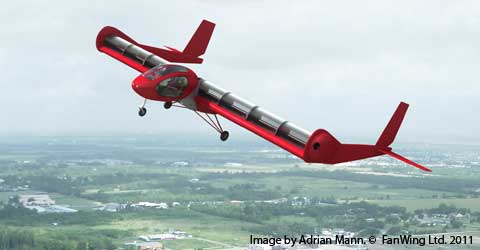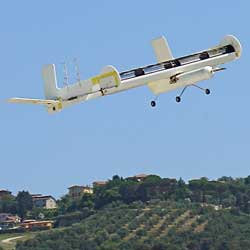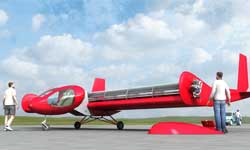
Very little of Patrick Peebles’ invention could be called conventional. The FanWing looks like someone has put the blades of a combine harvester behind a helicopter cockpit and forgotten about the rest of the fuselage. That combine harvester, the FanWing propulsion system, is a fan in a wing, making it a thick wing that provides lift and thrust.
It has a fixed wing but can autorotate like a helicopter. It has two engines, but they are at either end of the wing. It has two booms instead of one. Its inventor is American, but this invention has been developed in England and Italy. Its lift efficiency is so good that university studies in the United Kingdom have concluded 100 horsepower could lift 5,732 pounds.
This has been proven through wind-tunnel testing at Imperial College London, work carried out at Kingston University London, and scale-model flight tests funded by the development agency of London, England, and the U.K. government’s equivalent of the U.S. federal department of commerce. The aircraft’s efficiency is achieved because the air is accelerated twice: First the rotor accelerates it as the blades rise from the front bottom to the top and then again as the rotor moves back toward the wing’s trailing edge.
The FanWing has two engines for redundancy. One engine can keep the aircraft in the air and give it the power to climb. But if the worst happens pilots can autorotate down with a glide ratio of about 3:1. Peebles likes to say the FanWing is similar to a helicopter but with a much simpler drive train.
The high lift efficiency, according to Peebles, gives it good stall resistance, stability in turbulence, short takeoff and landing capability, and good fuel economy. The wing’s twin-tail outboard stabiliser configuration avoids a strong downwash behind the wing and recovers energy from the wingtip vortex upwash. This is not just theory: Since June a 5.57-foot wingspan remote-controlled prototype with a takeoff distance of 12 feet and takeoff weight of 20.9 pounds has been flying at up to 40.5 knots for 10 minutes or more to a few hundred feet altitude. Based on this prototype’s performance Peebles predicts a full-sized 22,000-pound FanWing aircraft would have a cruise speed of around 100 knots.
 A scale-model remote-control FanWing has been flying in Italy. © FanWing Ltd. 2011
A scale-model remote-control FanWing has been flying in Italy. © FanWing Ltd. 2011
Peebles doesn’t have the funds to develop such a large aircraft that could be an airliner or cargo carrier; instead he is aiming at a two-seat light sport class technology demonstrator that he wants to fly publicly for the first time at the Experimental Aircraft Association’s (EAA) AirVenture in Oshkosh, Wis., in 2013.
Alameda, Calif.-based marine and aerospace components manufacturer Photon Composites Inc. will build the FanWing technology prototype. Photon’s owner, British-born engineer Richard Jenkins, has supported new transport technologies before. He was a director of the British environmental transportation project Greenbird, a wind-powered vehicle that achieved 126.2 mph on Ivanpah Dry Lake in California in March 2009.
The total length of the prototype demonstrator, including the wing’s tails, will be 22.9 feet, and its total width with its outboard stabilisers will be 45.9 feet, including 32.8 feet of wingspan. Preliminary studies indicate that the two-seater will have an empty weight of 661.3 pounds and two 50-hp two-cycle engines driving either side of the FanWing rotor. The cruise speed is expected to be about 60 knots, with a top speed of 80 knots. The rotor speed will be 1,500 rpm, and flight control will come from the rotor rpm and the tail surfaces. Its takeoff distance is expected to be 49.2 feet.
Still looking for investors so he can build the demonstrator and then get the necessary FAA and EAA approvals for the 2013 flight, Peebles expects to display a static model of the technology demonstrator at next year’s Oshkosh show.
He said the light sport aircraft “is a major new phase for the company. This interim technology demonstrator will on one side take us forward on the [research and development] R&D and on the other side offers a neat little STOL [short takeoff and landing] light aircraft.”
International interest in the FanWing has seen the Aerodynamics Research Institute of Chinese aircraft maker AviChina investigate the concept and publish a technical paper on it. To protect the intellectual property Peebles now has patents in 10 countries including the United States, China, Australia, and various European countries.
Over the last 10 years of development Peebles has counted about 100 investors as his FanWing supporters, and he is in talks with potential new partners. The twin-tail outboard stabilisers, Peebles believes, have made the FanWing more commercially attractive because the new configuration has increased the forward speed to the equivalent of a civilian helicopter. Previous studies of other FanWing configurations had predicted a slow cruise speed.
 The FanWing looks like someone has put the blades of a combine harvester behind a helicopter cockpit and forgotten about the rest of the fuselage. Image by Adrian Mann, © FanWing Ltd. 2011
The FanWing looks like someone has put the blades of a combine harvester behind a helicopter cockpit and forgotten about the rest of the fuselage. Image by Adrian Mann, © FanWing Ltd. 2011
“George Seyfang originally suggested the twin tail, then got involved in the tests and has basically turned things round for us,” said Peebles. Seyfang, a retired BAE Systems principal future concept engineer, joined the FanWing team two years ago. Seyfang spent his career working on aerodynamics at BAE’s Warton Aerodrome site in northern England. BAE is the U.K. aerospace manufacturer whose antecedent companies built the Supermarine Spitfire, Hawker Siddeley Harrier GR7 “jump-jet” and the British Aircraft Corp. Concorde. All of these aircraft are classic designs, and if Peebles and Seyfang can succeed, the FanWing may join them in the aviation hall of fame.
Robert Coppinger is an aviation journalist based in London, England.

